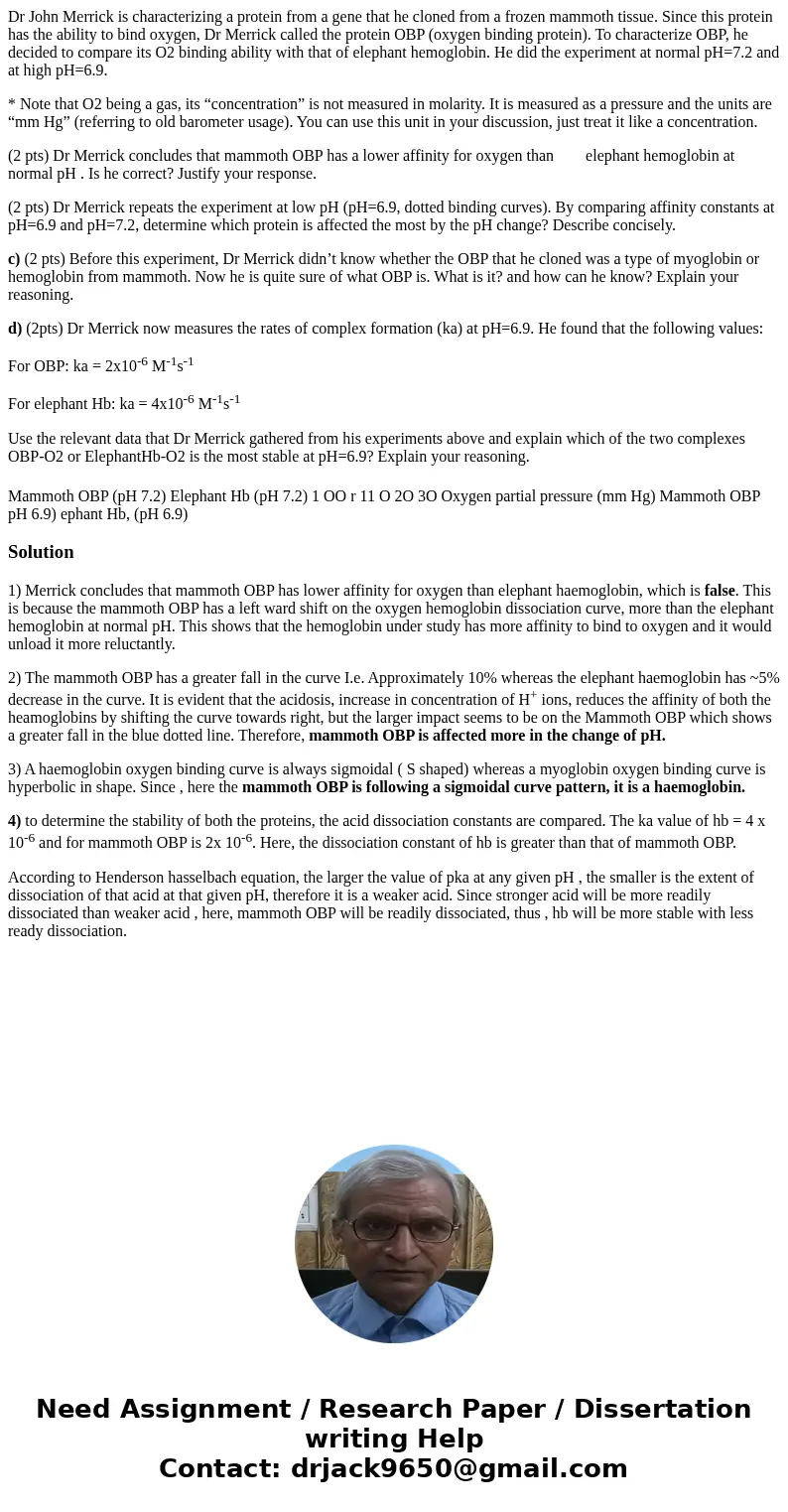Dr John Merrick is characterizing a protein from a gene that
Dr John Merrick is characterizing a protein from a gene that he cloned from a frozen mammoth tissue. Since this protein has the ability to bind oxygen, Dr Merrick called the protein OBP (oxygen binding protein). To characterize OBP, he decided to compare its O2 binding ability with that of elephant hemoglobin. He did the experiment at normal pH=7.2 and at high pH=6.9.
* Note that O2 being a gas, its “concentration” is not measured in molarity. It is measured as a pressure and the units are “mm Hg” (referring to old barometer usage). You can use this unit in your discussion, just treat it like a concentration.
(2 pts) Dr Merrick concludes that mammoth OBP has a lower affinity for oxygen than elephant hemoglobin at normal pH . Is he correct? Justify your response.
(2 pts) Dr Merrick repeats the experiment at low pH (pH=6.9, dotted binding curves). By comparing affinity constants at pH=6.9 and pH=7.2, determine which protein is affected the most by the pH change? Describe concisely.
c) (2 pts) Before this experiment, Dr Merrick didn’t know whether the OBP that he cloned was a type of myoglobin or hemoglobin from mammoth. Now he is quite sure of what OBP is. What is it? and how can he know? Explain your reasoning.
d) (2pts) Dr Merrick now measures the rates of complex formation (ka) at pH=6.9. He found that the following values:
For OBP: ka = 2x10-6 M-1s-1
For elephant Hb: ka = 4x10-6 M-1s-1
Use the relevant data that Dr Merrick gathered from his experiments above and explain which of the two complexes OBP-O2 or ElephantHb-O2 is the most stable at pH=6.9? Explain your reasoning.
Solution
1) Merrick concludes that mammoth OBP has lower affinity for oxygen than elephant haemoglobin, which is false. This is because the mammoth OBP has a left ward shift on the oxygen hemoglobin dissociation curve, more than the elephant hemoglobin at normal pH. This shows that the hemoglobin under study has more affinity to bind to oxygen and it would unload it more reluctantly.
2) The mammoth OBP has a greater fall in the curve I.e. Approximately 10% whereas the elephant haemoglobin has ~5% decrease in the curve. It is evident that the acidosis, increase in concentration of H+ ions, reduces the affinity of both the heamoglobins by shifting the curve towards right, but the larger impact seems to be on the Mammoth OBP which shows a greater fall in the blue dotted line. Therefore, mammoth OBP is affected more in the change of pH.
3) A haemoglobin oxygen binding curve is always sigmoidal ( S shaped) whereas a myoglobin oxygen binding curve is hyperbolic in shape. Since , here the mammoth OBP is following a sigmoidal curve pattern, it is a haemoglobin.
4) to determine the stability of both the proteins, the acid dissociation constants are compared. The ka value of hb = 4 x 10-6 and for mammoth OBP is 2x 10-6. Here, the dissociation constant of hb is greater than that of mammoth OBP.
According to Henderson hasselbach equation, the larger the value of pka at any given pH , the smaller is the extent of dissociation of that acid at that given pH, therefore it is a weaker acid. Since stronger acid will be more readily dissociated than weaker acid , here, mammoth OBP will be readily dissociated, thus , hb will be more stable with less ready dissociation.

 Homework Sourse
Homework Sourse